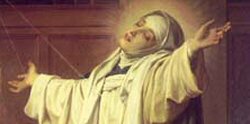On January 3, 2009, to my great joy I was solemnly consecrated to a life of virginity in the Archdiocese of New York. That is, I as a virgin was wholly dedicated to God as a “spouse of Christ,” through my reception of an ancient Rite of Consecration by the authority of the local bishop.
Consecrated virginity is actually the oldest form of consecrated life in the Catholic Church, predating religious life by centuries. There are references to consecrated virgins in the Church during Apostolic times, and the central prayer of the Rite of Consecration has been traditionally ascribed to St. Matthew the Evangelist. Before it was historically possible for a woman to enter a religious Order and become a nun, she could offer her life to God as a consecrated virgin. Well-known consecrated virgins from the early Church include St. Agnes, St. Agatha, St. Cecilia, and St. Lucy.
With the rise of monasticism beginning in about the fourth century A.D., the practice of consecrating women living “in the world,” or outside of monasteries, gradually fell into disuse until it was formally discontinued around the year 1000. However, the rite was preserved by certain religious Orders, who continued to use the ritual for their solemnly professed nuns. Then in the later half of the twentieth century, with the decree of the second Vatican Council Sacrosanctum Concilium, the Rite of Consecration to a Life of Virginity was revised and the vocation of consecrated virginity in the world was reinstituted in the modern Church.
In my own life, I was twelve years old when I first felt called to dedicate my life exclusively to Christ. At the time, I assumed that I would eventually enter a convent and become a nun or a religious sister. But when at age eighteen I first began to visit various religious communities and discern my vocation more seriously, I started to sense that God was calling me to something other than religious life. This confused and upset me until several months later, when providentially I was able to read the Rite of Consecration to a Life of Virginity for Women Living in the World. Almost at once I knew that I had found my vocation, although it was not until this January, at age twenty-three, that I was able to receive consecration.
The Rite of Consecration always takes place within the context of a Mass. Because I live in a large archdiocese, for pastoral reasons my consecration was delegated to the auxiliary bishop who serves as the Episcopal Vicar for my county. The consecration Mass took place in the parish where the bishop is stationed, about a ten-minute drive from my home parish.

(Photo above) This is the very beginning of the entrance procession. I walked just behind the cross-bearer, followed by the two women whom the Rite of Consecration directs to accompany the candidate (almost like bridesmaids), then by the concelebrating priests and deacons, and finally by the consecrating bishop.



(Photo above) Following this, as I prepared to offer my life to God, I lay prostrate in the sanctuary while the Litany of the Saints was chanted.
(Photo above) At the conclusion of the Litany, I knelt before the bishop and made a public declaration of my resolve to remain a virgin for the sake of the Kingdom of Heaven. The technical term for this is a propositum—which is similar, but not identical to, a promise or vow made in religious profession.
(Photo above) Then, I knelt while the bishop prayed the ancient and beautiful consecratory prayer. This prayer is actually the effective element of the Rite of Consecration to a Life of Virginity; unlike religious profession, where a person is consecrated by the promises he or she actively makes, a virgin is consecrated through her passive reception of this solemn blessing and prayer of the Church. Because of this, there is no possibility of dispensation from a life of consecrated virginity. (Photo above) After the consecratory prayer, I receive a veil, a ring, and a breviary. Here, I am receiving the Liturgy of the Hours, with the commission to pray.
(Photo above) After the consecratory prayer, I receive a veil, a ring, and a breviary. Here, I am receiving the Liturgy of the Hours, with the commission to pray.

(Photo above) After the Consecration Rites, I returned to my place in the sanctuary before the Liturgy of the Eucharist. The rest of the Mass continued as usual, but with the special additions to the Eucharistic prayer as indicated in the Sacramentary for a Mass of Consecration.

(Above photo) After the Consecration Mass, we had a simple (but big!) reception with my family and friends in the parish hall. Here, I am standing with three seminarian-friends whom I met in college (including, at the far right, Don Maloney from the Diocese of Raleigh, N.C.). All of them here served at the Mass.
In my new life as a consecrated virgin, I am called to spend my life in prayer and service to the Church. Presently, I am full-time graduate student studying for a Master’s degree in Catholic Theology. Eventually I hope to earn a doctorate in either Theology or Canon Law and teach at a university level—but as my main priority is serving the Church, I would be open to using my education in other, perhaps non-academic ways if the needs of the Church suggested this.
But more importantly, every day I attend Mass, pray the full Divine Office, and spend other time in personal prayer. My primary intention is for the needs of the bishops, clergy, and people of the Archdiocese of New York, though the Rite of Consecration also calls me to “pray without ceasing for the salvation of the world.”
Consecrated virginity is actually the oldest form of consecrated life in the Catholic Church, predating religious life by centuries. There are references to consecrated virgins in the Church during Apostolic times, and the central prayer of the Rite of Consecration has been traditionally ascribed to St. Matthew the Evangelist. Before it was historically possible for a woman to enter a religious Order and become a nun, she could offer her life to God as a consecrated virgin. Well-known consecrated virgins from the early Church include St. Agnes, St. Agatha, St. Cecilia, and St. Lucy.
With the rise of monasticism beginning in about the fourth century A.D., the practice of consecrating women living “in the world,” or outside of monasteries, gradually fell into disuse until it was formally discontinued around the year 1000. However, the rite was preserved by certain religious Orders, who continued to use the ritual for their solemnly professed nuns. Then in the later half of the twentieth century, with the decree of the second Vatican Council Sacrosanctum Concilium, the Rite of Consecration to a Life of Virginity was revised and the vocation of consecrated virginity in the world was reinstituted in the modern Church.
In my own life, I was twelve years old when I first felt called to dedicate my life exclusively to Christ. At the time, I assumed that I would eventually enter a convent and become a nun or a religious sister. But when at age eighteen I first began to visit various religious communities and discern my vocation more seriously, I started to sense that God was calling me to something other than religious life. This confused and upset me until several months later, when providentially I was able to read the Rite of Consecration to a Life of Virginity for Women Living in the World. Almost at once I knew that I had found my vocation, although it was not until this January, at age twenty-three, that I was able to receive consecration.
The Rite of Consecration always takes place within the context of a Mass. Because I live in a large archdiocese, for pastoral reasons my consecration was delegated to the auxiliary bishop who serves as the Episcopal Vicar for my county. The consecration Mass took place in the parish where the bishop is stationed, about a ten-minute drive from my home parish.

(Photo above) This is the very beginning of the entrance procession. I walked just behind the cross-bearer, followed by the two women whom the Rite of Consecration directs to accompany the candidate (almost like bridesmaids), then by the concelebrating priests and deacons, and finally by the consecrating bishop.

(Photo above) From the introductory rites through most of the Liturgy of the Word, the candidate is seated in the body of the Church. Then, after the Gospel, she is called by the bishop into the sanctuary—this is what constitutes a “vocation” in an official sense.
-

(Photo above) After I was called, I entered the sanctuary as I made the liturgical response: “Now with all my heart I follow you, I reverence you and seek your presence. Lord, fulfill my hope; show me your loving kindness, the greatness of your mercy.”
Then I sat in the sanctuary while the bishop preached a homily on the nature and purpose of consecrated virginity.
After the homily, I stood before the bishop and affirmed that I was willing to accept my vocation with all its attendant responsibilities.
Then I sat in the sanctuary while the bishop preached a homily on the nature and purpose of consecrated virginity.
After the homily, I stood before the bishop and affirmed that I was willing to accept my vocation with all its attendant responsibilities.

(Photo above) Following this, as I prepared to offer my life to God, I lay prostrate in the sanctuary while the Litany of the Saints was chanted.
-

(Photo above) At the conclusion of the Litany, I knelt before the bishop and made a public declaration of my resolve to remain a virgin for the sake of the Kingdom of Heaven. The technical term for this is a propositum—which is similar, but not identical to, a promise or vow made in religious profession.
-

(Photo above) Then, I knelt while the bishop prayed the ancient and beautiful consecratory prayer. This prayer is actually the effective element of the Rite of Consecration to a Life of Virginity; unlike religious profession, where a person is consecrated by the promises he or she actively makes, a virgin is consecrated through her passive reception of this solemn blessing and prayer of the Church. Because of this, there is no possibility of dispensation from a life of consecrated virginity.
 (Photo above) After the consecratory prayer, I receive a veil, a ring, and a breviary. Here, I am receiving the Liturgy of the Hours, with the commission to pray.
(Photo above) After the consecratory prayer, I receive a veil, a ring, and a breviary. Here, I am receiving the Liturgy of the Hours, with the commission to pray.
(Photo above) After the Consecration Rites, I returned to my place in the sanctuary before the Liturgy of the Eucharist. The rest of the Mass continued as usual, but with the special additions to the Eucharistic prayer as indicated in the Sacramentary for a Mass of Consecration.

(Above photo) After the Consecration Mass, we had a simple (but big!) reception with my family and friends in the parish hall. Here, I am standing with three seminarian-friends whom I met in college (including, at the far right, Don Maloney from the Diocese of Raleigh, N.C.). All of them here served at the Mass.
In my new life as a consecrated virgin, I am called to spend my life in prayer and service to the Church. Presently, I am full-time graduate student studying for a Master’s degree in Catholic Theology. Eventually I hope to earn a doctorate in either Theology or Canon Law and teach at a university level—but as my main priority is serving the Church, I would be open to using my education in other, perhaps non-academic ways if the needs of the Church suggested this.
But more importantly, every day I attend Mass, pray the full Divine Office, and spend other time in personal prayer. My primary intention is for the needs of the bishops, clergy, and people of the Archdiocese of New York, though the Rite of Consecration also calls me to “pray without ceasing for the salvation of the world.”
























No comments:
Post a Comment